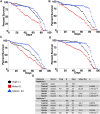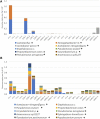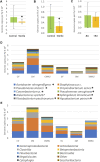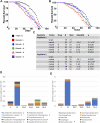Mifepristone Increases Life Span in Female Drosophila Without Detectable Antibacterial Activity
- PMID: 35935727
- PMCID: PMC9354577
- DOI: 10.3389/fragi.2022.924957
Mifepristone Increases Life Span in Female Drosophila Without Detectable Antibacterial Activity
Abstract
Mifepristone dramatically increases the life span of mated female Drosophila while reducing the expression of innate immune response genes. Previous results indicated that mifepristone also reduced the load of aero-tolerant bacteria in mated females. Experiments were conducted to further investigate the possible role of bacteria in mifepristone life span effects. Life span was assayed in flies grown from sterilized eggs on autoclaved media and in normally cultured controls in two independent assays. Sterilization increased mated female life span (+8.3% and +57%, respectively), and the effect of mifepristone was additive (+53% and +93%, respectively). High-throughput sequencing of 16S sequences revealed that sterilization reduced the abundance of multiple species and the classes Bacteroidia, Bacilli, Actinobacteria, and Cytophagia. By contrast, mifepristone caused no decreases and instead increased the abundance of three species. Five aero-tolerant bacterial species were cultured from extracts of mated female flies, including both Gram-positive and Gram-negative species (Acetobacter sicerae, Enterococcus faecalis, Lactobacillus plantarum, Serratia rubidea, and Paenibacillus glucanolyticus). There was no detectable effect of mifepristone on the growth of these bacteria in vitro, indicating that mifepristone does not have a direct antibiotic effect. To test if antibiotics could mimic the effects of mifepristone in vivo, mated female flies were treated throughout adult life span with high concentrations of the individual antibiotics doxycycline, ampicillin, kanamycin, and streptomycin, in replicate experiments. No significant effect on life span was observed for ampicillin, kanamycin, or streptomycin, and an inconsistent benefit was observed for doxycycline. Finally, supplementation of media with Enterococcus faecalis did not alter adult female life span in the presence or absence of mifepristone. Taken together, the results indicate the life span benefits of mifepristone are not due to an antibiotic effect.
Keywords: Drosophila; aging; bacteria; microbiome; mifepristone; steroid.
Copyright © 2022 Landis, Riggan, Bell, Vu, Wang, Wang, Tejawinata, Ko and Tower.
Conflict of interest statement
The authors declare that the research was conducted in the absence of any commercial or financial relationships that could be construed as a potential conflict of interest.
Figures







Similar articles
-
Mifepristone and rapamycin have non-additive benefits for life span in mated female Drosophila.Fly (Austin). 2024 Dec;18(1):2419151. doi: 10.1080/19336934.2024.2419151. Epub 2024 Oct 23. Fly (Austin). 2024. PMID: 39440794 Free PMC article.
-
Dhr96[1] mutation and maternal tudor[1] mutation increase life span and reduce the beneficial effects of mifepristone in mated female Drosophila.PLoS One. 2023 Dec 21;18(12):e0292820. doi: 10.1371/journal.pone.0292820. eCollection 2023. PLoS One. 2023. PMID: 38127988 Free PMC article.
-
A screen of small molecule and genetic modulators of life span in female Drosophila identifies etomoxir, RH5849 and unanticipated temperature effects.Fly (Austin). 2022 Dec;16(1):397-413. doi: 10.1080/19336934.2022.2149209. Fly (Austin). 2022. PMID: 36412257 Free PMC article.
-
Mifepristone Increases Life Span of Virgin Female Drosophila on Regular and High-fat Diet Without Reducing Food Intake.Front Genet. 2021 Sep 24;12:751647. doi: 10.3389/fgene.2021.751647. eCollection 2021. Front Genet. 2021. PMID: 34659367 Free PMC article.
-
Mifepristone/RU486 acts in Drosophila melanogaster females to counteract the life span-shortening and pro-inflammatory effects of male Sex Peptide.Biogerontology. 2017 Jun;18(3):413-427. doi: 10.1007/s10522-017-9703-y. Epub 2017 Apr 27. Biogerontology. 2017. PMID: 28451923 Free PMC article.
Cited by
-
Conditional Inhibition of Eip75B Eliminates the Effects of Mating and Mifepristone on Lifespan in Female Drosophila.Cells. 2024 Jun 28;13(13):1123. doi: 10.3390/cells13131123. Cells. 2024. PMID: 38994975 Free PMC article.
-
Mifepristone and rapamycin have non-additive benefits for life span in mated female Drosophila.Fly (Austin). 2024 Dec;18(1):2419151. doi: 10.1080/19336934.2024.2419151. Epub 2024 Oct 23. Fly (Austin). 2024. PMID: 39440794 Free PMC article.
-
Dhr96[1] mutation and maternal tudor[1] mutation increase life span and reduce the beneficial effects of mifepristone in mated female Drosophila.PLoS One. 2023 Dec 21;18(12):e0292820. doi: 10.1371/journal.pone.0292820. eCollection 2023. PLoS One. 2023. PMID: 38127988 Free PMC article.
-
A screen of small molecule and genetic modulators of life span in female Drosophila identifies etomoxir, RH5849 and unanticipated temperature effects.Fly (Austin). 2022 Dec;16(1):397-413. doi: 10.1080/19336934.2022.2149209. Fly (Austin). 2022. PMID: 36412257 Free PMC article.
References
-
- Bernal-Sore I., Navarro-Marquez M., Osorio-Fuentealba C., Díaz-Castro F., Del Campo A., Donoso-Barraza C., et al. (2018). Mifepristone Enhances Insulin-Stimulated Akt Phosphorylation and Glucose Uptake in Skeletal Muscle Cells. Mol. Cell. Endocrinol. 461, 277–283. 10.1016/j.mce.2017.09.028 - DOI - PubMed
Grants and funding
LinkOut - more resources
Full Text Sources
Molecular Biology Databases

